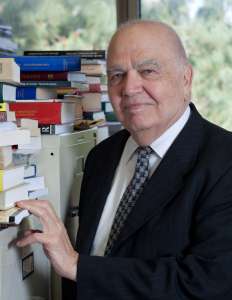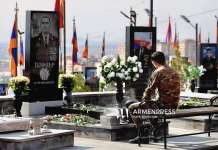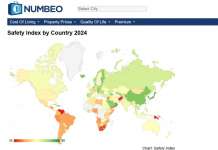Obituary: Prof. Richard Hovannisian (1932-2023)
 On July 10, the Society for Armenian Studies, the academic world, the field of Armenian Studies, and the Armenian nation lost one of the most prominent icons of the modern period: Prof. Richard G. Hovannisian. Hovannisian was a monumental figure in the field of Armenian Studies. Considered as the Dean of Modern Armenian History, he established the field of Modern Armenian History in the Western Hemisphere. He supported the establishment of some of the most important chairs in Armenian Studies in the United States. Hovannisian was the child of Genocide survivors. His father, Kaspar Gavroian, was born in in the village of Bazmashen near Kharpert in 1901. Unlike others, he survived the Genocide and arrived in the U.S. He changed his last name from Gavroian to Hovannisian after his father Hovannes. In 1928 Kaspar married Siroon Nalbandian, the child of Genocide survivors. They had four sons: John, Ralph, Richard, and Vernon. Richard was born in Tulare, California, on November 9, 1932. Being the son of Genocide survivors played an important role in his academic path. In 1957, he married Dr. Vartiter Kotcholosian in Fresno and had four children: Raffi, Armen, Ani, and Garo. Raffi would become the first Minister of Foreign Affairs (1991-1992) of the Modern Republic of Armenia.
On July 10, the Society for Armenian Studies, the academic world, the field of Armenian Studies, and the Armenian nation lost one of the most prominent icons of the modern period: Prof. Richard G. Hovannisian. Hovannisian was a monumental figure in the field of Armenian Studies. Considered as the Dean of Modern Armenian History, he established the field of Modern Armenian History in the Western Hemisphere. He supported the establishment of some of the most important chairs in Armenian Studies in the United States. Hovannisian was the child of Genocide survivors. His father, Kaspar Gavroian, was born in in the village of Bazmashen near Kharpert in 1901. Unlike others, he survived the Genocide and arrived in the U.S. He changed his last name from Gavroian to Hovannisian after his father Hovannes. In 1928 Kaspar married Siroon Nalbandian, the child of Genocide survivors. They had four sons: John, Ralph, Richard, and Vernon. Richard was born in Tulare, California, on November 9, 1932. Being the son of Genocide survivors played an important role in his academic path. In 1957, he married Dr. Vartiter Kotcholosian in Fresno and had four children: Raffi, Armen, Ani, and Garo. Raffi would become the first Minister of Foreign Affairs (1991-1992) of the Modern Republic of Armenia.
Hovannisian began his academic life in 1954 by earning a B.A. in History, followed by an M.A. in History from the University of California, Berkley. In 1966, he earned his Ph.D. from the University of California, Los Angeles (UCLA). His dissertation was published in 1967 with the title Armenia on the Road to Independence which was the precursor to the four-volume magnum opus The Republic of Armenia. Hovannisian played an important role in establishing the teaching of Armenian history at UCLA. In 1987, he became the first holder of the Armenian Education Foundation Chair in Modern Armenian History at UCLA, which after his retirement was named in his honor as the Richard Hovannisian Endowed Chair in Modern Armenian History, with Prof. Sebouh Aslanian as its first incumbent.
Hovannisian was a Guggenheim Fellow and received numerous prestigious national and international awards for his service to the field and civic activities. He served on the Board of Directors of multiple national and international educational institutions and was a member of the Armenian National Academy of Sciences. After finishing his four-volume The Republic of Armenia, he dedicated his research and career to battling the denial of Armenian Genocide, resurrecting the history of Armenian towns and villages of the Armenian Provinces of the Ottoman Empire, and writing textbooks on modern Armenian history. Although not a scholar of Armenian Genocide, he has contributed more to the discipline than many others in the field. He edited multiple volumes on different facets of the Armenian Genocide, including historical, literary, and artistic perspectives. Hovannisian also spearheaded a monumental project to preserve the eyewitness accounts of the Armenian Genocide survivors.
In the 1970s, he launched the Armenian Genocide oral history project. He and his students interviewed more than 1,000 Armenian Genocide survivors in California. In 2018, Hovannisian donated the collection to the USC Shoah Foundation’s Visual History Archive to be available to scholars around the world. He single-handedly edited and published 15 volumes with Mazda Press as part of the UCLA Armenian History & Culture Series. The 15 volumes covered the history of Armenians in Van/Vaspourakan, Cilicia (with Simon Payaslian), Sivas/Sepastia, Trebizond/Trabzon, Baghesh/Bitlis, Taron/Mush, Smyrna/Izmir, Kesaria/Kayseri and Cappadocia among other places. The final book in the series, The Armenians of Persia/Iran, was published in 2022. Hovannisian’s also edited the two-volume The Armenian People from Ancient to Modern Times, which is considered a classic Armenian History textbook.
Hovannisian came from a generation that fought against the stifling of Armenian voices within the fields of Middle Eastern and Ottoman Studies, which had relegated Armenian Studies to second-class status. He fought for the relevance of Armenian Studies within these fields and tirelessly fought against the efforts to marginalize Armenian issues and to deny the Armenian Genocide.
Besides his contribution to the field, Hovannisian also mentored and educated multiple generations of scholars and thousands of students. He was a strict mentor who demanded that his students work to reach their full potential. He wanted to make sure that they would survive and thrive in the tough terrain of the academic job market.
In his lifetime, Hovannisian was especially influenced by two people: his wife Vartiter and Simon Vratsian (the last Prime Minister of the First Republic of Armenia). Vartiter was his life’s partner for more than half a century. Her dedication to Richard and the field of Armenian Studies played an important role in shaping who Richard became. Vartiter was an intellectual companion who read and reviewed every piece that he wrote. She was also a constant presence at every conference he planned or attended. In the early 1950s, Vratsian, the author of a major book on the First Republic, became Hovannisian’s mentor when he studied Armenian language at the Hamazkayin Nishan Palanjian Jemaran in Beirut, Lebanon. This influence led Hovannisian to write the first academic work on the First Republic of Armenia and created the first step for his academic career.
In 1974, Hovannisian along with Dickran Kouymjian, Nina Garsoïan, Avedis Sanjian, and Robert Thomson spearheaded the project to establish a Society for Armenian Studies (SAS). Considered as the pillars of Armenian Studies, the main objective of this group was the development of Armenian Studies as an academic discipline. With access to very limited resources, this group of scholars was able to establish the foundations of a Society that would play a dominant role in developing Armenian Studies in North America and beyond. From a handful of chairs and programs that supported the initiative at the time, today Armenian Studies as a discipline has flourished in the United States with more than thirteen chairs and programs providing their unconditional support to the Society. Hovannisian was the president of SAS for three terms (1977, 1991-1992, 2006-2009). During his tenure the Society flourished and was able to achieve major accomplishments in the field.
In 2019, the Society for Armenian Studies awarded Hovannisian with the SAS Life Time Achievement Award in recognition and appreciation for his outstanding service and contribution to the field of Armenian Studies.
Hovannisian’s legacy will remain for generations to come.
Our hearts go out to his family and beloved ones.
Regards,
Bedross Der Matossian
Past President of SAS (2018-2022)
University of Nebraska, Lincoln











